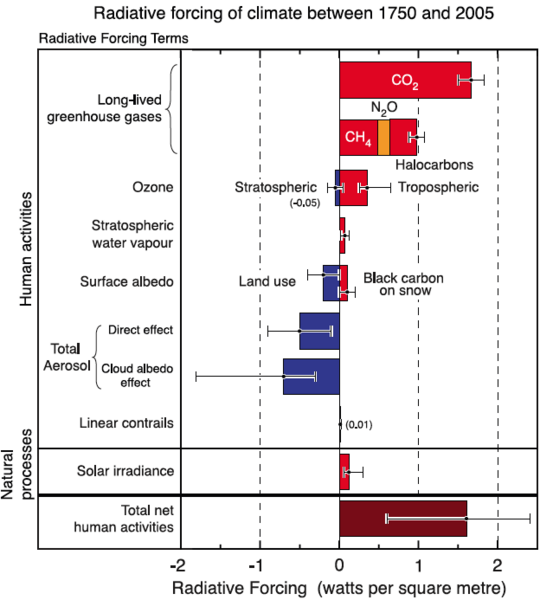This is the first of a two-part “Explained” on the scientific concepts underlying the concept of the greenhouse effect and global climate change.
When people talk about global warming or the greenhouse effect, the main underlying scientific concept that describes the process is radiative forcing. And despite all the recent controversy over leaked emails and charges of poorly sourced references in the last Intergovernmental Panel on Climate Change report, the basic concept of radiative forcing is one on which scientists — whatever their views on global warming or the IPCC — all seem to agree. Disagreements come into play in determining the actual value of that number.
The concept of radiative forcing is fairly straightforward. Energy is constantly flowing into the atmosphere in the form of sunlight that always shines on half of the Earth’s surface. Some of this sunlight (about 30 percent) is reflected back to space and the rest is absorbed by the planet. And like any warm object sitting in cold surroundings — and space is a very cold place — some energy is always radiating back out into space as invisible infrared light. Subtract the energy flowing out from the energy flowing in, and if the number is anything other than zero, there has to be some warming (or cooling, if the number is negative) going on.
It’s as if you have a kettle full of water, which is at room temperature. That means everything is at equilibrium, and nothing will change except as small random variations. But light a fire under that kettle, and suddenly there will be more energy flowing into that water than radiating out, and the water is going to start getting hotter.
In short, radiative forcing is a direct measure of the amount that the Earth’s energy budget is out of balance.
For the Earth’s climate system, it turns out that the level where this imbalance can most meaningfully be measured is the boundary between the troposphere (the lowest level of the atmosphere) and the stratosphere (the very thin upper layer). For all practical purposes, where weather and climate are concerned, this boundary marks the top of the atmosphere.
While the concept is simple, the analysis required to figure out the actual value of this number for the Earth right now is much more complicated and difficult. Many different factors have an effect on this balancing act, and each has its own level of uncertainty and its own difficulties in being precisely measured. And the individual contributions to radiative forcing cannot simply be added together to get the total, because some of the factors overlap — for example, some different greenhouse gases absorb and emit at the same infrared wavelengths of radiation, so their combined warming effect is less than the sum of their individual effects.
In its most recent report in 2007, the IPCC produced the most comprehensive estimate to date of the overall radiative forcing affecting the Earth today. Ronald Prinn, the TEPCO Professor of Atmospheric Science and director of MIT’s Center for Global Change Science, was one of the lead authors of that chapter of the IPCC’s Fourth Assessment Report. Radiative forcing “was very small in the past, when global average temperatures were not rising or falling substantially,” he explains. For convenience, most researchers choose a “baseline” year before the beginning of world industrialization — usually either 1750 or 1850 — as the zero point, and compute radiative forcing in relation to that base. The IPCC uses 1750 as its base year and it is the changes in the various radiative forcing agents since then that are counted.
Thus radiative forcing, measured in watts per square meter of surface, is a direct measure of the impact that recent human activities — including not just greenhouse gases added to the air, but also the impact of deforestation, which changes the reflectivity of the surface — are having on changing the planet’s climate. However, this number also includes any natural effects that may also have changed during that time, such as changes in the sun’s output (which has produced a slight warming effect) and particles spewed into the atmosphere from volcanoes (which generally produce a very short-lived cooling effect, or negative forcing).
Although all of the factors that influence radiative forcing have uncertainties associated with them, one factor overwhelmingly affects the uncertainty: the effects of aerosols (small airborne particles) in the atmosphere. That’s because these effects are highly complex and often contradictory. For example, bright aerosols (like sulfates from coal-burning) are a cooling mechanism, whereas dark aerosols (like black carbon from diesel exhausts) lead to warming. Also, adding sulfate aerosols to clouds leads to smaller but more abundant droplets that increase cloud reflectivity, thus cooling the planet.
“The error bars in the greenhouse gas forcing are very small,” Prinn says. “The biggest uncertainty in defining radiative forcing comes from aerosols.”
So, given all these factors and their range of errors, what’s the answer? The current level of radiative forcing, according to the IPCC AR4, is 1.6 watts per square meter (with a range of uncertainty from 0.6 to 2.4). That may not sound like much, Prinn says, until you consider the total land area of the Earth and multiply it out, which gives a total warming effect of about 800 terawatts — more than 50 times the world’s average rate of energy consumption, which is currently about 15 terawatts.
Part two of this series will examine the concept of climate sensitivity, which determines how much the planet’s temperature will change due to a given radiative forcing.
When people talk about global warming or the greenhouse effect, the main underlying scientific concept that describes the process is radiative forcing. And despite all the recent controversy over leaked emails and charges of poorly sourced references in the last Intergovernmental Panel on Climate Change report, the basic concept of radiative forcing is one on which scientists — whatever their views on global warming or the IPCC — all seem to agree. Disagreements come into play in determining the actual value of that number.
The concept of radiative forcing is fairly straightforward. Energy is constantly flowing into the atmosphere in the form of sunlight that always shines on half of the Earth’s surface. Some of this sunlight (about 30 percent) is reflected back to space and the rest is absorbed by the planet. And like any warm object sitting in cold surroundings — and space is a very cold place — some energy is always radiating back out into space as invisible infrared light. Subtract the energy flowing out from the energy flowing in, and if the number is anything other than zero, there has to be some warming (or cooling, if the number is negative) going on.
It’s as if you have a kettle full of water, which is at room temperature. That means everything is at equilibrium, and nothing will change except as small random variations. But light a fire under that kettle, and suddenly there will be more energy flowing into that water than radiating out, and the water is going to start getting hotter.
In short, radiative forcing is a direct measure of the amount that the Earth’s energy budget is out of balance.
For the Earth’s climate system, it turns out that the level where this imbalance can most meaningfully be measured is the boundary between the troposphere (the lowest level of the atmosphere) and the stratosphere (the very thin upper layer). For all practical purposes, where weather and climate are concerned, this boundary marks the top of the atmosphere.
While the concept is simple, the analysis required to figure out the actual value of this number for the Earth right now is much more complicated and difficult. Many different factors have an effect on this balancing act, and each has its own level of uncertainty and its own difficulties in being precisely measured. And the individual contributions to radiative forcing cannot simply be added together to get the total, because some of the factors overlap — for example, some different greenhouse gases absorb and emit at the same infrared wavelengths of radiation, so their combined warming effect is less than the sum of their individual effects.
In its most recent report in 2007, the IPCC produced the most comprehensive estimate to date of the overall radiative forcing affecting the Earth today. Ronald Prinn, the TEPCO Professor of Atmospheric Science and director of MIT’s Center for Global Change Science, was one of the lead authors of that chapter of the IPCC’s Fourth Assessment Report. Radiative forcing “was very small in the past, when global average temperatures were not rising or falling substantially,” he explains. For convenience, most researchers choose a “baseline” year before the beginning of world industrialization — usually either 1750 or 1850 — as the zero point, and compute radiative forcing in relation to that base. The IPCC uses 1750 as its base year and it is the changes in the various radiative forcing agents since then that are counted.
Thus radiative forcing, measured in watts per square meter of surface, is a direct measure of the impact that recent human activities — including not just greenhouse gases added to the air, but also the impact of deforestation, which changes the reflectivity of the surface — are having on changing the planet’s climate. However, this number also includes any natural effects that may also have changed during that time, such as changes in the sun’s output (which has produced a slight warming effect) and particles spewed into the atmosphere from volcanoes (which generally produce a very short-lived cooling effect, or negative forcing).
Although all of the factors that influence radiative forcing have uncertainties associated with them, one factor overwhelmingly affects the uncertainty: the effects of aerosols (small airborne particles) in the atmosphere. That’s because these effects are highly complex and often contradictory. For example, bright aerosols (like sulfates from coal-burning) are a cooling mechanism, whereas dark aerosols (like black carbon from diesel exhausts) lead to warming. Also, adding sulfate aerosols to clouds leads to smaller but more abundant droplets that increase cloud reflectivity, thus cooling the planet.
“The error bars in the greenhouse gas forcing are very small,” Prinn says. “The biggest uncertainty in defining radiative forcing comes from aerosols.”
So, given all these factors and their range of errors, what’s the answer? The current level of radiative forcing, according to the IPCC AR4, is 1.6 watts per square meter (with a range of uncertainty from 0.6 to 2.4). That may not sound like much, Prinn says, until you consider the total land area of the Earth and multiply it out, which gives a total warming effect of about 800 terawatts — more than 50 times the world’s average rate of energy consumption, which is currently about 15 terawatts.
Part two of this series will examine the concept of climate sensitivity, which determines how much the planet’s temperature will change due to a given radiative forcing.







